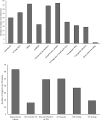Perceptions on HIV Pre-Exposure Prophylaxis Among Urgent Care Clinicians in the Southern United States
- PMID: 35473523
- PMCID: PMC9562460
- DOI: 10.2174/1570162X20666220426094920
Perceptions on HIV Pre-Exposure Prophylaxis Among Urgent Care Clinicians in the Southern United States
Abstract
Background: Underutilization of HIV pre-exposure prophylaxis (PrEP) in the Southern United States (US) is well-documented. Urgent care (UC) centers are positioned as communityfacing access points to PrEP, but the feasibility of integrating PrEP services into this setting is unclear. We conducted a survey of UC clinicians in the Southern US to better understand their perceptions of the feasibility of providing PrEP in their practice setting.
Objective: The study aims to determine the feasibility and acceptability of providing PrEP services in the UC setting through a cross-sectional survey of UC clinicians.
Methods: We conducted a 48-item cross-sectional survey of UC clinicians in the Southern US, between July and September 2020. The survey was distributed through the Urgent Care Association (UCA) and American Academy of Urgent Care Medicine (AAUCM) professional listservs as well as directly to publicly listed e-mail addresses.
Results: Eighty-two clinicians responded to the survey. Most clinicians had familiarity with PrEP (97%). All respondents rated PrEP as an effective way to prevent HIV. However, less than half felt UC facilities were an appropriate place to prescribe PrEP. Few respondents (8%) expressed doubts that expansion of PrEP access would decrease the incidence of HIV in their community.
Conclusion: These findings show UC clinicians are familiar with PrEP, and many believe it would benefit their patients; however, provider opinions on the appropriateness of providing PrEP in the UC setting differ. Further studies on PrEP implementation in UC centers are needed.
Keywords: HIV pre-exposure prophylaxis; PrEP; sexually transmitted infections; southern United States; survey; urgent care.
Copyright© Bentham Science Publishers; For any queries, please email at epub@benthamscience.net.
Figures


References
Publication types
MeSH terms
Substances
Grants and funding
LinkOut - more resources
Full Text Sources
Medical
Miscellaneous

